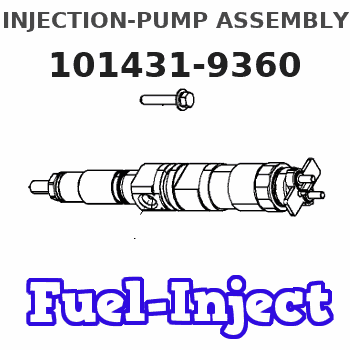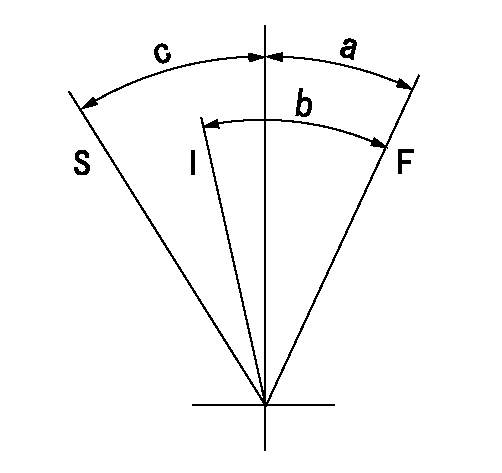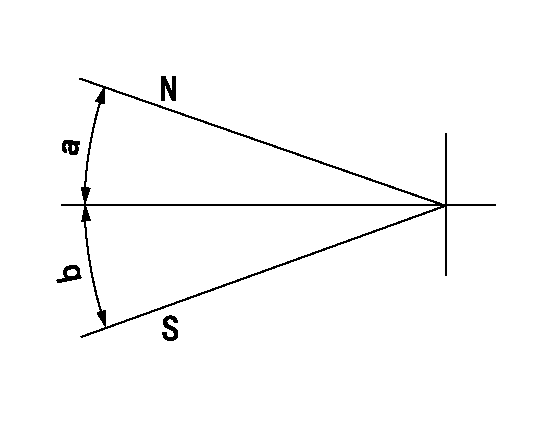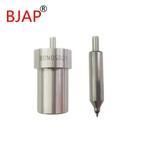Information injection-pump assembly
ZEXEL
101431-9360
1014319360
NISSAN-DIESEL
1671290012
1671290012

Rating:
Service parts 101431-9360 INJECTION-PUMP ASSEMBLY:
1.
_
6.
COUPLING PLATE
7.
COUPLING PLATE
8.
_
9.
_
11.
Nozzle and Holder
16600-90019
12.
Open Pre:MPa(Kqf/cm2)
9.8{100}
15.
NOZZLE SET
Cross reference number
ZEXEL
101431-9360
1014319360
NISSAN-DIESEL
1671290012
1671290012
Zexel num
Bosch num
Firm num
Name
101431-9360
1671290012 NISSAN-DIESEL
INJECTION-PUMP ASSEMBLY
SD22 * K
SD22 * K
Calibration Data:
Adjustment conditions
Test oil
1404 Test oil ISO4113 or {SAEJ967d}
1404 Test oil ISO4113 or {SAEJ967d}
Test oil temperature
degC
40
40
45
Nozzle and nozzle holder
105780-8140
Bosch type code
EF8511/9A
Nozzle
105780-0000
Bosch type code
DN12SD12T
Nozzle holder
105780-2080
Bosch type code
EF8511/9
Opening pressure
MPa
17.2
Opening pressure
kgf/cm2
175
Injection pipe
Outer diameter - inner diameter - length (mm) mm 6-2-600
Outer diameter - inner diameter - length (mm) mm 6-2-600
Tester oil delivery pressure
kPa
157
157
157
Tester oil delivery pressure
kgf/cm2
1.6
1.6
1.6
Direction of rotation (viewed from drive side)
Right R
Right R
Injection timing adjustment
Direction of rotation (viewed from drive side)
Right R
Right R
Injection order
1-3-4-2
Pre-stroke
mm
2.3
2.25
2.35
Beginning of injection position
Drive side NO.1
Drive side NO.1
Difference between angles 1
Cal 1-3 deg. 90 89.5 90.5
Cal 1-3 deg. 90 89.5 90.5
Difference between angles 2
Cal 1-4 deg. 180 179.5 180.5
Cal 1-4 deg. 180 179.5 180.5
Difference between angles 3
Cyl.1-2 deg. 270 269.5 270.5
Cyl.1-2 deg. 270 269.5 270.5
Injection quantity adjustment
Adjusting point
A
Rack position
14
Pump speed
r/min
750
750
750
Average injection quantity
mm3/st.
32
31
33
Max. variation between cylinders
%
0
-2.5
2.5
Basic
*
Fixing the lever
*
Injection quantity adjustment_02
Adjusting point
B
Rack position
11.8
Pump speed
r/min
750
750
750
Average injection quantity
mm3/st.
19.5
18
21
Max. variation between cylinders
%
0
-4
4
Fixing the rack
*
Injection quantity adjustment_03
Adjusting point
C
Rack position
10.8
Pump speed
r/min
300
300
300
Average injection quantity
mm3/st.
7.5
6.4
8.6
Max. variation between cylinders
%
0
-15
15
Fixing the rack
*
Timer adjustment
Pump speed
r/min
500
Advance angle
deg.
0.5
Timer adjustment_02
Pump speed
r/min
550
Advance angle
deg.
0.7
Timer adjustment_03
Pump speed
r/min
700
Advance angle
deg.
1
0.5
1.5
Timer adjustment_04
Pump speed
r/min
(895)
Advance angle
deg.
2
1.5
2.5
Timer adjustment_05
Pump speed
r/min
-
Advance angle
deg.
5
5
5
Remarks
Measure the actual speed, stop
Measure the actual speed, stop
Test data Ex:
Governor adjustment

N:Pump speed
R:Rack position (mm)
----------
----------
----------
----------
Speed control lever angle

F:Full speed
I:Idle
S:Stop
----------
----------
a=10deg+-5deg b=27deg+-5deg c=32deg+-3deg
----------
----------
a=10deg+-5deg b=27deg+-5deg c=32deg+-3deg
Stop lever angle

N:Pump normal
S:Stop the pump.
----------
----------
a=(19deg) b=(34deg)
----------
----------
a=(19deg) b=(34deg)
Information:
External Leaks
LOSS OF COOLANT 1. Leaks In Hoses Or ConnectionsCheck all hoses and connections for visual signs of leakage. If no leaks are found, look for damage to hoses or loose hose clamps. Also, check for leaks in accessories such as fuel heaters and transmission oil coolers.2. Leaks In The Radiator And/Or Expansion TankPut pressure to the radiator and/or expansion tank with the 9S8140 Cooling System Pressurizing Pump Group and check for leaks.3. Leaks In The HeaterPut pressure to the cooling system with the 9S8140 Cooling System Pressurizing Pump Group and check the heater for leaks.4. Leaks In The Water PumpCheck the water pump for leaks before starting the engine, then start the engine and look for leaks. If there are leaks at the water pump, repair the pump or install a new pump.5. Cylinder Head Gasket LeaksLook for leaks along the surface of the cylinder head gasket. If leaks are found, remove the cylinder head and install a new head gasket.Coolant Leaks At The Overflow Tube
6. Defective Pressure Cap Or Relief ValveCheck the sealing surfaces of the pressure cap and the radiator to be sure the cap is sealing correctly. Check the opening pressure and sealing ability of the pressure cap or relief valve with the 9S8140 Cooling System Pressurizing Pump Group.7. Engine Runs Too HotIf coolant temperature is too high, pressure will be high enough to move the cap off of the sealing surface in the radiator and cause coolant loss through the overflow tube. If this occurs, refer to the portion, Overheating, of the topic, Abnormal Cooling System.8. Expansion Tank Too Small Or Installed IncorrectlyThe expansion tank can either be a part of the radiator or it can be installed separately from the radiator. The expansion tank must be large enough to hold the expansion of the coolant as it gets warm or has sudden changes in pressure. Verify that the expansion tank is installed correctly and that it is the proper size according to the specifications of the Truck Manufacturer.9. Air Bubbles Present In The CoolantPossible causes:* a damaged head gasket* a crack in the cylinder head* a crack in the spacer block* a crack in one of the cylinder liners* a crack in one of the injector sleevesRemove the radiator cap and start the engine. Check for bubbles in the coolant. If bubbles are present, then begin engine disassembly. Remove the cylinder head and check for cracks in the internal components. Follow the disassembly procedures as outlined in 3176 Diesel Truck Engine Disassembly and Assembly, Form. No. SENR3914.Internal Leakage
If coolant is found in the engine oil check the following internal components for damage:10. Cylinder Head Gasket LeakageIf the cylinder head gasket leaks between a water passage and an opening into the crankcase, coolant will enter the crankcase.11. Cracks In The Cylinder HeadCracks in the upper surface of the cylinder head, or in an area between a water passage and an opening into the crankcase, can allow coolant to enter the crankcase.12. Cracks
LOSS OF COOLANT 1. Leaks In Hoses Or ConnectionsCheck all hoses and connections for visual signs of leakage. If no leaks are found, look for damage to hoses or loose hose clamps. Also, check for leaks in accessories such as fuel heaters and transmission oil coolers.2. Leaks In The Radiator And/Or Expansion TankPut pressure to the radiator and/or expansion tank with the 9S8140 Cooling System Pressurizing Pump Group and check for leaks.3. Leaks In The HeaterPut pressure to the cooling system with the 9S8140 Cooling System Pressurizing Pump Group and check the heater for leaks.4. Leaks In The Water PumpCheck the water pump for leaks before starting the engine, then start the engine and look for leaks. If there are leaks at the water pump, repair the pump or install a new pump.5. Cylinder Head Gasket LeaksLook for leaks along the surface of the cylinder head gasket. If leaks are found, remove the cylinder head and install a new head gasket.Coolant Leaks At The Overflow Tube
6. Defective Pressure Cap Or Relief ValveCheck the sealing surfaces of the pressure cap and the radiator to be sure the cap is sealing correctly. Check the opening pressure and sealing ability of the pressure cap or relief valve with the 9S8140 Cooling System Pressurizing Pump Group.7. Engine Runs Too HotIf coolant temperature is too high, pressure will be high enough to move the cap off of the sealing surface in the radiator and cause coolant loss through the overflow tube. If this occurs, refer to the portion, Overheating, of the topic, Abnormal Cooling System.8. Expansion Tank Too Small Or Installed IncorrectlyThe expansion tank can either be a part of the radiator or it can be installed separately from the radiator. The expansion tank must be large enough to hold the expansion of the coolant as it gets warm or has sudden changes in pressure. Verify that the expansion tank is installed correctly and that it is the proper size according to the specifications of the Truck Manufacturer.9. Air Bubbles Present In The CoolantPossible causes:* a damaged head gasket* a crack in the cylinder head* a crack in the spacer block* a crack in one of the cylinder liners* a crack in one of the injector sleevesRemove the radiator cap and start the engine. Check for bubbles in the coolant. If bubbles are present, then begin engine disassembly. Remove the cylinder head and check for cracks in the internal components. Follow the disassembly procedures as outlined in 3176 Diesel Truck Engine Disassembly and Assembly, Form. No. SENR3914.Internal Leakage
If coolant is found in the engine oil check the following internal components for damage:10. Cylinder Head Gasket LeakageIf the cylinder head gasket leaks between a water passage and an opening into the crankcase, coolant will enter the crankcase.11. Cracks In The Cylinder HeadCracks in the upper surface of the cylinder head, or in an area between a water passage and an opening into the crankcase, can allow coolant to enter the crankcase.12. Cracks
Have questions with 101431-9360?
Group cross 101431-9360 ZEXEL
Nissan-Diesel
101431-9360
1671290012
INJECTION-PUMP ASSEMBLY
SD22
SD22
